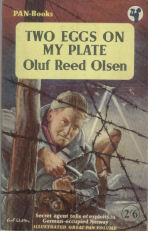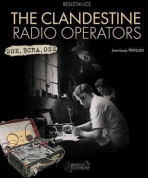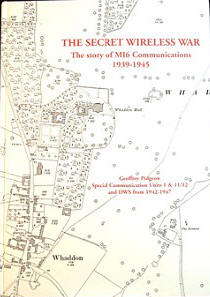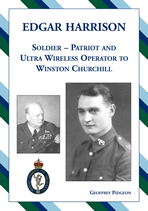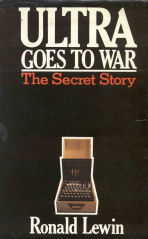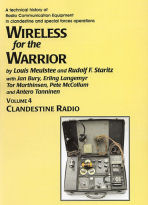Books concerning Whaddon Mk-VII, a.k.a. The Paraset, SIS, SOE, MI6, a.s.o.
—– Comments and/or questions? Mail to: parasetguy AT vanzwamcs.com
Many books are written about the role of secret services and spies during World War II. These books are a welcome source of information on behalf of our projects, or very interesting read on the subject.
I invite the reader of this page to submit his comments on the books, I will add these to obtain an objective source of information for future buyers. I don’t sell books nor have any financial interest in the books or traders mentioned.
2010-03-04
Because of the enthusiast reactions on this page I have decided to open it for everybody to add the books they have read on the subject that interest us, Parasetteers.
In order not to clutter the page with descriptions of thousands of fiction novels, I limit the descriptions to the following subjects: Paraset, spying, secret agents, resistance. The stories have to cover World War 2 and must be historically correct.
The books will be described with their official excerpt or flap or back text. A picture of the book will be displayed, if available. Than, everybody is invited to comment the book. Everybody can send in a book description for adding to this site. This description should be accompanied with a readers comment.
A Short History of the British Secret Intelligence Service, MI-6 – by Richard M. Bennett
As the title says: a few pages in which the history of the developement of Britisch intelligence services is revealed.
This PDF file is available for downloading.
Title: Two eggs on my plate
Author: Oluf Reed Olsen
ISBN: n.a.
text below, taken from www.abebooks.com
“Two eggs were an airman’s special treat before setting out on a dangerous mission.“
The story starts in Norway in 1940. Olsen, the author, after a desperate escape from Norway in a small, leaky boat which was blown back by a gale from the coast of Scotland to the coast of Denmark, was trained in Canada and later dropped by parachute over southern Norway. His job was to watch and report the movements of shipping. In the face of persistent attempts by the Germans to find him and his concealed radio, he travelled about by train and bicycle. He reveals the elaborate organization of the underground movement and describes the courage of the Norwegian resisters. A best-selling account of hairbreadth escapes.
*** This book was later published as an abridged version called: Assignment: Spy.
About the author: Oluf Reed Olsen:
Bernhard Oluf Reed Olsen (born 1. January 1918 – Died 1. October 2002), Son of Christen Reed Olsen and Bergljot Halvorsen, Was a Norwegian pilot, resistance fighter and writer. He grew up in Montebello in Oslo and graduated as a pilot in Widerøe before World War II. After the war he conducted some minor sabotage and intelligence operations, was captured but escaped by Lysaker bru during transport for questioning in Oslo. Together with a friend, he set out the 2.september 1940 to England in a 22-foot sailboat.
After a dramatic passage, which in general are well described in the book “We’ll be back”, he sojourned a short time in London and then went on to training camp “Little Norway” in Canada. In 1941-1942 he flew Northrop N-3PB in 330 Squadron on Iceland. He was in 1943, trained as a paratrooper and a secret agent Secret Intelligence Service (SIS) in England only to be released in the parachute of Norway. He headed the intelligence group “Aquila” at Southern, but the group eventually moved to Oslo. In May 1944, he again dropped out of Norway to conduct intelligence, but in October the same year he had to escape via Sweden to England. The group he led was credited for a total of 183 000 tonnes of tonnage sunk.
He continued in the military after the war, and was in a period of time head of the flight department in NAL – the precursor to the SAS. He was also very active in Scouting and was awarded the Scout Association white glory lily.
Oluf was an adopted child.
For his war efforts, he was awarded:
•War Cross with swords
•Distinguished Service Cross
•War Medal
•Haakon VII Medal
•Participant Medal with rosette
Comment: — by Tom, DJ5RE
It was pretty hard to find the book somewhere. I had luck to get one second hand in the UK. The book was in pretty bad shape, with a strong smell and some mildew stains indicating it was stored in a room with too much moisture. I placed it near the pellet-oven in the basement to dry it and get off some of the “old smell”. Then I went outside to clean each side with a brush in hope to remove the traces of dried mould.
The book is a treasure! What a story! But these lines were not created in the head of an author who knows how to write a book that sells: This is a real story! With this book we’ve got a very precious time document, that helps to understand the jobs that were done by using a “Paraset”.
Although the book has not much technical information about the radio sets itself, we learn how they were operated. I was astonished that there were real 2-way contacts in transceive mode. I always thought they used it as a transmitter that was uncritical in frequency stability due to the crystal control, and used the receiver to get orders or listen to the BBC. Using it for 2-way contacts meant that the receiver had to be brought back to frequency each time after transmitting, as the receiver’s voltage was cut off during transmitting and the box got pretty much mechanical vibrations from punching the built in key during the transmission. There was no band spread like most of the replicas we have build. I am sure the receiver was off frequency after each transmission. Of course there was the fine-tuning knob with the friction drive on receiving, but there were several MHz spreaded over only 180 deg. of the tuning capacitor. All this demanded all operator skills. Later in the book Oluf reported of a new American radio set that satisfied him very much, as the tuning behaviour was very comfortable and it put out about 22 W. May be someone has an idea which set it could have been?
For me, getting as much as background information and stories about the Parasets in their job they were made for, helps to lift the process of building a replica to something special. I will remember the stories each time I work on this box.
Tom, DJ5RE
Where to buy?
Try to find it on www.abebooks.com, mainly used, because the book is out of print.
Title: The Clandestine Radio Operators
Author: Jean-Louis Perquin
ISBN 10: 2352501830; ISBN 13: 9782352501831
text, taken from www.amazon.com
All Resistance and radio buffs have been waiting for this book, abundantly illustrated (300 photos 70 of which in color) and giving an exhaustive account of the real champions of Free France – the Allied underground radio operators parachuted into Occupied Territory.
Ruthlessly pursued by the Germans, the radio operators had a life expectancy of six months… For the first time, the training they received in England is described in detail and five accounts describe how these heroes lived daily. Most of the radio equipment, some of which is very rare, is shown for the first time with color photos. The son of a Resistance worker, Jean-Louis Perquin has earned the friendship and the trust of the veterans and has drawn attention to himself by publishing articles on what Allied special agents wore when they were dropped into enemy occupied territory. In touch with a lot of historians and museum curators in the States, Great Britain, Norway and France, he has drawn up this first title in the “Resistance” collection with devotion and humility.
Comment: — by Tom, DJ5RE
I was getting in touch with “Clandestine Radio” from the technical side. When I heard there is a book about this topic, I decided to buy it. I was very impressed about those high-quality pictures, showing the big variation of those radio sets as well as a lot of picture documents. But the book offers much more. The reader learns about the education, the organization and the risks of being a clandestine radio operator. Introducing some of the agents personally gives this topic a face, and reading about their history was very touching. I will now build my Paraset with another view on the topic.
Where to buy?
Go to: www.amazon.com Or try to find it on www.abebooks.com.
Title: The Secret Wireless War – The story of MI6 Communications from 1939 – 1945
Author: Geoffrey Pidgeon
ISBN: 978-09560515-2-3
text, taken from www.abebooks.com
Possibly the most important UK wireless traffic in World War II was handled by a unit formed in 1938 by Brigadier Richard Gambier-Parry head of MI6 Section VIII – the communications division of SIS. This book tells of its formation and includes diary entries by one of the ‘founding fathers’ recording the secret meetings that took place, and the assembly of its talented staff.
It reports the earlier days of the original SIS wireless ‘Station X’ based in Barnes in south west London, and the building of its second station in a bungalow in Surrey with the strange name of ‘Funny Neuk’ – which turned out to be owned by Admiral Sir Hugh Sinclair – ‘C’ – Chief of Secret Intelligence Services.
The units wireless station at Bletchley Park is described and its replacement by the stations at nearby Whaddon Hall which then became the wartime headquarters of Section VIII. It documents the work of our agents in embassies abroad, and of those in German occupied territories; the story of Churchill’s personal wireless operator, and there is the description by a German soldier of the Afrika Corps of his operating an Enigma machine at Rommel’s headquarters in the desert.
The curious story of ‘Black Propaganda’ is told and the units handling of the military ULTRA traffic out to commanders in the field. Personal tales by those who were part of this most secret of units abound in the book and it is an important record of people and events that-it is no exaggeration to say-helped to win the war. Whilst essential, the technical side of the tale has not been allowed to dominate the book which is profusely illustrated.
Comment: — by Henk
I read this one. Very interesting and enjoyable to read, gives great insight in history. Not only in the secret organisations, but also the history of the places where they were housed. A lot of photos put faces to the names and involves the reader in reliving the historic events. The book is further more a collection of personal stories, told by the men that experienced the stories. The author worked in the metal shops at Whaddon, doing metal work a.o. on frame and Morse keys of the MK-VII.
Interested in the Paraset? Read this book!
Where to buy?
Go to: http://www.bletchleypark.org.uk/shop/view_product.rhtm/133065/238227/detail.html and support that Foundation. Or try to find it on www.abebooks.com.
Title: Edgar Harrison – Soldier, Patriot and Ultra Wireless Operator to Winston Churchill
Author: Geoffrey Pidgeon
ISBN: 978-09560515-0-9
text, taken from www.geoffreypidgeon.com
Geoffrey Pidgeon became a wartime colleague of Edgar Harrison when he joined MI6 Section VIII at Whaddon Hall. Geoffrey launched his hugely successful book ‘The Secret Wireless War’ at Bletchley Park in 2003. It has become a unique reference to the vital role played by MI6 (Section VIII) in their interception of enemy wireless communications in World War II, and its later dissemination of the ‘Ultra’ intelligence gleaned from it by code breakers at Bletchley Park.
In 2005 Geoffrey finally persuaded Edgar to write his incredible story. However, Edgar, already in his nineties, sadly died later that year before the work was finished. Geoffrey took up the reins and worked tirelessly going through Edgar’s notes. There were many gaps in the story that he has since filled in with research. However, although credited as the author, Geoffrey wishes to be known more as an editor who merely provided the ‘finish’ to the work.
About the author: Geoffrey Pidgeon
Geoffrey was born in Fulham in 1926. The family moved to Caterham in Surrey in the early 1930’s and he was educated at Caterham School. In 1940, the home was slightly damaged during the Battle of Britain being fought in the skies overhead. It was decided to move to Stony Stratford to be near to his father who was, by now, working for MI6 (Section VIII) at Whaddon Hall near Bletchley Park.
In 1947 he joined the family bathroom business, retiring when he was 80. He has now been married to Jane for 60 years; they have three sons who are the fifth generation of the family to be involved in the bathroom and kitchen business. He has voluntarily worked for numerous bodies in the industry; he served on its Metrication Board, over the years he was a member of 22 BSI committees, chaired one, and led BSI delegations to Paris on European Standards. He has written and lectured on bathroom products and design. His paper about ‘Safety in the Bathroom’ is still quoted today. His most recent achievement, and one he is quite proud of, is helping to alter the UK water regulations to allow the use of the superior valve (‘push button’) fitting to WC cisterns instead of the outdated and water-wasteful siphon.
Comment:
Not available, yet.
Where to buy?
Try to find it on www.abebooks.com – print to order services are sometimes cheapest.
Title: Ultra goes to war – The first account of World War II’s greatest secret based on official documents
Author: Ronald Lewin
ISBN: 0-671-82844-4
text, taken from www.abebooks.com
This book was published thirty years ago, just a few years after the information concerning the breaking of the German Enigma cipher machine was made public. It was one of the first books to look at the impact of this breakthrough on the Western European aspects of WWII. It does More…not describe any of the actual code breaking per se, only the important influence that this had on the war.
Given that the book is thirty years old and that newer books covering the Enigma cipher and the Ultra secret have been published, one can reasonably ask why they should invest time on this book. I think that this book is useful because: 1. It is the classic source that many other books reference 2. Being written 25 years after the end of the war, the author had a very important perspective and was allowed to interview many of the participants. Twenty five to forty years is, in my opinion, the best time frame to write a history of any event. Twenty-five years gives some time for emotions to cool and allow for a more dispassionate look at events (a little longer is even better). Unfortunately, after 40 years many of the senior participants are dead, making interviews impossible. Thus, this book was written at the beginning of this critical period. Books written today must rely on previously published books (like this one) and on dairies, manuscripts and archives. 3. I have read a number of the more recent books concerning the Ultra secret but I have still learned new things from this book. For instance, I learned that the Colossus computer was developed not to break the Enigma code, but to break a sophisticated radio-teletype code. The book makes it clear the B-Dienst (a German code breaking group) broke
Flap text (3rd impression, Dec. 1978):
A NEW ERA
Reviewing ULTRA GOES TO WAR in The Sunday Times, Michael Howard, the military historian, wrote:
‘This is perhaps the most important book to have appeared on the Second World War since Chester Wilmot wrote The Struggle for Europe a quarter of a century ago. Like Wilmot, Lewin is a professional writer rather than an academic historian, and thus unafraid to tackle a large theme and address himself to a popular audience. Like him, he has had access to a mass of new documentary material and to many of the people whose activities he describes; and like him he has revealed an entirely new dimension in the conduct of the war. ..All historians must now read what Lewin has to say before putting pen to paper: A new era in Second World War historiography has begun…
‘He has established a clear and definitive account of the way in which German ciphers came to be broken, of the establishment and functioning of the interception centre at Bletchley Park, and of the process by which its intercepts were distributed to the service authorities whose plans they affected. Secondly; and yet more important, he has set on foot what will inevitably be a prolonged and controversial process: the assessment of the impact of Ultra on the conduct of the war by land, sea and air. ..
‘Ronald Lewin’s work is only the beginning. Every book ever written, to take only one example, about the campaigns in the Western Desert is now out of date. All must now be re-examined in the light of the information about the enemy which we now know was available to the commanders on both sides. But it will take a historian of Mr Lewin’s skill, patience and experience to make a real go of it.
Comment:
Not available, yet.
Where to buy?
Try to find it on www.abebooks.com – print to order services are sometimes cheapest.
Title: Wireless for the Warrior – Volume 4 “Clandestine Radio”
Author: Louis Meulstee
ISBN: 0952063 36 0
text, taken from http://wftw.nl/
First published September 2004 by Wimborne Publishing Limited, Ferndown, Dorset, U.K.
About Volume 4 “Clandestine Radio“
This Volume is different in approach to the previous books in this series. Although it still contains a mix of technical data, photographs, line drawings and circuit diagrams, no extensive descriptions are provided, principally to limit the number of pages but also for reasons of non availability of detailed information of the majority of sets. I am very pleased to announce that this Volume is a combined effort of Rudolf Staritz, myself and a number of other authors, notably Jan Bury, Erling Langemyr, Tor Marthinsen, Pete McCollum and Antero Tanninen, experts in their own field and living in various parts of the world.
The time period imposed on the selection of sets to be included in this volume stretches from about 1938 up to the early 1990s, approximately to the fall of the Berlin wall. No attempts were taken to include satellite equipment and radios which might be still in current use.
It must be noted that apart from Clandestine, Agents or ‘Spy’ radio equipment, sets which were used by Special Forces, Partisans, Resistance, ‘Stay Behind’ organisations, Australian Coast Watchers and Diplomatic Service will also be covered, in addition to selected associated power sources, RDF and intercept receivers, bugs and radio- and radar beacons.
Comment: — by Henk
A great book with a lot of technical information. It is a reference book, so real “reading” in it, won’t happen. But it is interesting to see the development of the radio’s over the years and one can be stunned over the great things people created to answer to the special demands. Information on Paraset is a bit scarce, though. Mr. Meulstee wrote several books on the subject of military radio, very worth while. Check out the others on aforementioned website.
Where to buy?
The first published books can be obtained direct from the publisher Wimborne Publishing Ltd., the later books directly from the “Wireless for the Warrior“-website.

